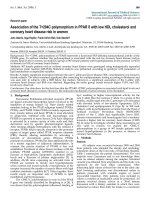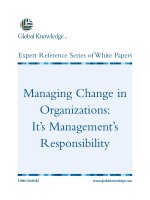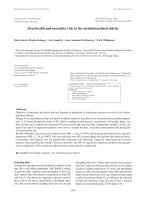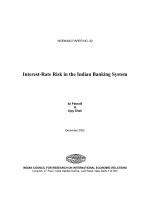Mananging risk in organizations
Bạn đang xem bản rút gọn của tài liệu. Xem và tải ngay bản đầy đủ của tài liệu tại đây (1015.99 KB, 287 trang )
Managing Risk in Organizations
J. Davidson Frame
Q
Managing Risk
in Organizations
A Guide for Managers
Copyright © 2003 by J. Davidson Frame.
Published by Jossey-Bass
A Wiley Imprint
989 Market Street, San Francisco, CA 94103-1741 www.josseybass.com
No part of this publication may be reproduced, stored in a retrieval system, or transmitted in
any form or by any means, electronic, mechanical, photocopying, recording, scanning, or
otherwise, except as permitted under Section 107 or 108 of the 1976 United States Copyright
Act, without either the prior written permission of the Publisher, or authorization through
payment of the appropriate per-copy fee to the Copyright Clearance Center, Inc., 222
Rosewood Drive, Danvers, MA 01923, 978-750-8400, fax 978-750-4470, or on the web at
www.copyright.com. Requests to the Publisher for permission should be addressed to the
Permissions Department, John Wiley & Sons, Inc., 111 River Street, Hoboken, NJ 07030,
201-748-6011, fax 201-748-6008, e-mail:
The Washington Post story on pp. 13–14 is © 2001, The Washington Post. Reprinted with
permission.
Jossey-Bass books and products are available through most bookstores. To contact Jossey-Bass
directly call our Customer Care Department within the U.S. at 800-956-7739, outside the U.S.
at 317-572-3986 or fax 317-572-4002.
Jossey-Bass also publishes its books in a variety of electronic formats. Some content that
appears in print may not be available in electronic books.
Library of Congress Cataloging-in-Publication Data
Frame, J. Davidson.
Managing risk in organizations : a guide for managers / by J. Davidson Frame.—1st ed.
p. cm.—(The Jossey-Bass business & management series)
Includes bibliographical references and index.
ISBN 0-7879-6518-9 (alk. paper)
1. Risk management. I. Title. II. Series.
HD61.F726 2003
658.15’5—dc21
2003008144
Printed in the United States of America
FIRST EDITION
HB Printing 10 9 8 7 6 5 4 3 2 1
The Jossey-Bass
Business & Management Series
Q Contents
Preface
About the Author
xi
xix
1
The Big Picture
2
Practical Limitations of Risk Management
17
3
Organizing to Deal with Risk
32
4
Identifying Risk
49
5
Assessing Impacts of Risk Events—
Qualitative Impact Analysis
68
Assessing Impacts of Risk Events—
Quantitative Analysis
83
6
1
Assessing the Impacts of Risk Events:
The Role of Probability and Statistics
104
8
Planning to Handle Risk
134
9
Monitoring and Controlling Risk
150
10
Business Risk
177
11
Operational Risks
204
12
Project Risk
227
13
Conclusions
248
References
255
Index
259
7
ix
To Yanping and Koko
Q Preface
Toward the end of the 1990s, we approached the coming millennium
with a foreboding that was similar to what our ancestors experienced
a thousand years earlier. In 999, many of them envisioned the new
millennium as ushering in Armageddon and the end of the world.
Today, we are more sophisticated. Like our ancestors, we saw the new
millennium as bringing chaos and uncertainty, but this time it assumed a peculiarly high-tech and secular cast in the form of what we
called “the Y2K problem.” We breathed a collective sigh of relief when
January 1, 2000, came and went with no collapse of our economic infrastructure. But whatever security we felt did not last long.
For the proponents of doom and gloom, the new millennium has
not been disappointing. Even as the economies of the industrialized
world reached unprecedented peaks of affluence at the outset of 2000,
they were caught in the grips of a free-fall decline within a year. Then
on September 11, 2001, an event of terrorism shook the capitalist
world to its roots. The attacks on the World Trade Center and Pentagon reinforced the view that despite all the appurtenances of wealth
and stability that we have grown accustomed to, the world is a dangerous place. The subsequent anthrax attack on the U.S. postal system
confirmed this perspective.
Fear of terrorism and uncertainty took a big toll on global stock markets. Stock prices plunged. Retirees who had jumped on the bull market
bandwagon toward the end of the 1990s watched their savings being
wiped out. The pounding of the stock market continued when the
largest financial scandals of modern times were revealed. Major corporations such as Enron, WorldCom, and Global Crossing confessed
that they had cooked their financial books, abetted by prestigious accounting firms such as Arthur Andersen LLP.
These events reminded us of something many of us had forgotten:
the world is a risky place. Planet Earth itself is a bull’s eye on a target;
one day an asteroid will hit the mark, with devastating consequences.
xi
xii
PREFACE
Global warming is causing ice caps to melt and sea levels to rise. One
portion of the planet experiences unprecedented floods, while another
faces unparalleled drought. Meanwhile, malcontents around the globe
justify unconscionable acts of murder and mayhem on religious, cultural, or political grounds. And financial markets regularly prove that
Newton’s views on gravity prevail: what goes up must come down.
Awareness of life’s dangers has sparked an interest in risk and its
consequences. Untoward events are occurring regularly throughout
the world. We are loathe to stand by passively as they ruin our lives.
The question many people raise is: What can we do to lessen the likelihood of their occurrence and to reduce their impacts when they do
arise? That is, what can we do to manage risk?
This book is written to help you understand and cope with the
risks you come across on the job. It examines the risks you routinely
encounter and explains their origins. It offers prescriptions for assessing their impacts and developing strategies to cope with them. It
suggests how you can organize your operations to deal with them. To
help you manage risk more effectively, it offers an abundance of tools
and techniques that risk practitioners regularly employ.
I have been teaching risk management in business schools and executive development programs since the mid-1980s. Although I have
come across a fair number of risk management books over the years,
I did not find any that addressed the risk management concerns of
general managers in business and government enterprises. This created problems for me because there was little written work I could use
to supplement my class presentations. The risk management books I
encountered focused on narrow areas. There are a number of excellent texts on understanding and handling risk from the perspective of
the insurance industry. I have come across other useful works that approach risk management from the purview of hazards and occupational safety. There are quite a few books written for investors in the
stock market that show readers how to accommodate investment risks.
Finally, there are substantial numbers of books that are heavily quantitative and approach risk management from the viewpoint of operations research. But there is very little that general managers would
find useful.
I hope this book fills the information gap that I perceive. I have designed it to provide managers with all they need to know in the risk
management arena. I have attempted to increase its relevance to general managers by offering a large number of practical examples and
case studies that bring theoretical principles to life. I have even in-
Preface
xiii
cluded a friendly primer on statistics: Chapter Seven will help managers appreciate better the quantitative aspects of risk management.
Beyond this, I have worked to make the book as up-to-date as possible. For example, I show how real options concepts borrowed from
the financial community can be employed to reduce project risk.
I encountered two major challenges in writing this book. The first
was putting boundaries around the topic. Everyone who works in the
risk area quickly recognizes that risk is ubiquitous. Insurance companies see it as the prospect of loss of or damage to assets. Financial investors see it in terms of returns on investments. Hazard and safety
managers approach it from the perspective of loss of life and limb. Environmentalists worry about damage to the environment. Project
managers are primarily concerned with the possibility of missing
deadlines, or encountering cost overruns, or not achieving specifications. Operations managers view it as the prospect of the breakdown
of basic processes. Scientists and engineers focus on their ability to
work in uncharted terrain to achieve results that have never before
been achieved. And the ordinary citizen encounters it in all of its manifestations: If I work in a room of smokers, will I get lung cancer?
Where should I invest my retirement savings to maximize returns and
minimize risk? Will I be able to handle a Christmas party with sixty
guests? Are my smoke detectors working?
The book’s title indicates the work’s boundaries. Managing Risk in
Organizations examines the daily risks we encounter as we carry out
our jobs in a business setting. The title is not fortuitous. I have already
written another book with the title Managing Projects in Organizations
(2003). In that work, I stress that your success or failure in executing
projects is more closely associated with organizational factors, such as
your ability to handle project politics and to motivate team members,
than with your skills in building a computerized schedule. Similarly,
in the business world, managing risk occurs within an organizational
context. If you ignore this context, your attempts at managing risk will
surely fail.
The second major challenge I faced when writing this book was to
establish a proper balance between the quantitative and qualitative dimensions of risk management. There are those who strongly believe
that the quantitative perspective has little to offer, because real-world
risks seldom lend themselves to ready and meaningful measurement.
After the 2001 terrorist attacks, I had several students ask me whether
I thought a quantitative approach to risk management could have predicted those catastrophic events. I answered no. But I added that a
xiv
PREFACE
quantitative approach could be enormously helpful in assessing the
economic, personal, and infrastructure damage resulting from a collapse of the twin towers. Thus, although it might not lead to accurate
predictions of the occurrence of a risk event, it could provide valuable
insights about its impact.
There are also those who believe that so long as risk management
is based on anecdotes and qualitative assessments, it lacks sufficient
rigor to make it truly useful. They are fond of quoting William Thomson, Lord Kelvin, who at the end of the nineteenth century stated that
if you are trying to explain something without including measures,
“your knowledge is of a meager and unsatisfactory kind” (Thomson,
1894). They point out that the tools of probability and statistics are
enormously helpful in identifying risk events and predicting their impacts and that they provide important insights that you cannot gain
from purely qualitative assessments.
The arguments of both sides have merit, which suggests that people
interested in managing risk effectively must steer a course between the
two extremes. We must acknowledge that there is much more to managing risk than plugging probability values into equations. And we must
also recognize that tools such as expected monetary value analysis and
Monte Carlo simulation have demonstrated their value over and over
again and that to ignore them weakens our ability to handle risk.
In this book, I provide readers with the quantitative background
they need to understand the basics of probability and statistics that
can help them improve their risk assessment capabilities. Readers with
good quantitative skills can breeze through the explanations. Those
who have eschewed math courses since squeaking through high school
algebra may have to work a little harder, but not that much. The quantitative skills the effective risk manager needs do not go much beyond
what you learned in high school.
ORGANIZATION OF THE BOOK
Chapters One through Three establish the context for understanding
risk management. Chapter One offers an overview. It defines the concept of risk and shows how it is closely tied to the amount of information that is available to make decisions: the less information is available,
the more risk you face. It describes various types of risk you can encounter: pure risk, operational risk, project risk, technical risk, business risk, and political risk. Finally, it offers a framework for handling
Preface
xv
risk: risk planning, risk identification, qualitative and quantitative impact analysis, risk response planning, and risk monitoring and control.
Chapter Two looks at the practical limitations of risk management.
It steps through the risk management process with a view to identifying things that it can and cannot do. The strengths and limitations of
risk management are illustrated through two detailed case studies.
Chapter Three examines how enterprises can organize their risk
management efforts. It emphasizes that effective risk management
does not happen by accident; it requires sustained support from the
most senior ranks of the enterprise and must be designed into the organization’s processes. These processes should enable staff to conduct
risk assessments, manage crises, and recover from disasters.
Chapters Four through Nine explore a systematic risk management
process comprising risk management planning, risk identification,
qualitative impact analysis, quantitative impact analysis, risk response
planning, and monitoring and control. Chapter Four describes the
importance of being able to identify risk events that you might encounter so that you are not surprised by untoward events. It presents
a number of techniques to help you in this undertaking, including employment of weighted checklists, risk logs, brainstorming sessions, behavioral models, diagramming techniques, flowcharting, and the
holding of productive meetings.
Chapter Five looks at qualitative approaches to determining the
impacts of risk events. It explores different ways that scenario building can be carried out to assist in this effort. It also examines the applicability of additional qualitative techniques, such as the likelihood
impact matrix, attribute analysis, and Delphi forecasting.
Chapter Six reviews quantitative approaches to determining the
impacts of risk events. It begins by stressing the importance of developing quantitative risk models, which can be as simple as a budget
captured on an electronic spreadsheet or as sophisticated as a fully developed Monte Carlo simulation that incorporates budget, schedule,
and resource data. It introduces readers to one of the most important
quantitative techniques in risk management, expected value analysis,
and describes the utility of benefit-cost analyses to handle risks associated with decision making.
Chapter Seven is a probability and statistics primer. It explains the
all-important concept of conditional probabilities and illustrates their
use in a real-world example. It also shows why statistical distributions—
in particular, the normal and PERT beta distributions—need to be
xvi
PREFACE
understood and belong in the competent risk manager’s toolbox. The
chapter concludes with a discussion of what transpires behind the
scenes when a Monte Carlo simulation is run.
Chapter Eight provides tips for developing strategies to handle the
risk events that you have identified. It focuses on four standard treatments: risk avoidance, risk mitigation, risk acceptance, and risk transfer. In addition, it describes how contracts are, at their heart, risk
management tools and shows readers how to calculate budget and
schedule reserves on their projects.
Chapter Nine, which addresses risk monitoring and control, goes
beyond assessment into the action phase of risk management. The fact
is that it is not enough simply to prepare for risk. You also need to be
able to deal with it once the risk events arise. Monitoring enables you
to keep your fingers on the pulse of the organization and its environment. By continual review of pending issues, for example, you may be
able to surface serious risk events while they are still small and manageable. Control requires you to get things back on track. If you are
facing a very bad situation, it may even require you to be good at managing crises; consequently, current perspectives on crisis management
are discussed in this chapter.
Chapters Ten through Twelve examine the special issues and features of business risk, operational risk, and project risk. In Chapter
Ten, readers see that an interesting aspect of business risk is that it offers the opportunity for gain as well as the prospect of loss. (Up to this
point of the book, the discussion has focused on pure risk, where concern is with loss.) It puts the spotlight on two special instances of
business risk: risk associated with new product development and financial risk.
Chapter Eleven looks at operational risk, that is, the risk associated
with carrying out operations. It examines sources of this type of risk,
including poorly formulated procedures, incompetence, and poor maintenance of equipment and software. It also makes the case that quality
management is a special case of risk management, because quality management is concerned with avoiding deviations from a norm. Consequently, the tools that have been developed in the quality management
arena turn out to be excellent for managing all types of operational
risks.
Chapter Twelve looks at project risk. It points out that Murphy’s
Law is hardwired into projects because of the way projects are carried
out. It identifies four predictable sources of project problems that risk
Preface
xvii
analyses should routinely monitor: organizational sources of problems, problems associated with poor management of needs and requirements, poor planning and control, and poor estimation. It
describes how each of these sources of problems can be handled.
Finally, Chapter Thirteen concludes the book by summarizing the
book’s main themes.
ACKNOWLEDGMENTS
A book like this is the sum total of the education and work experiences
an author accumulates over a lifetime. In my case, I began working on
the periphery of risk management a long time ago, when I focused my
attention on econometrics and statistics in graduate school in the 1960s
and 1970s. My first serious job had me engaged in technology forecasting. The point of the forecasts was to anticipate technology needs in the
short- and medium-term future so as to avoid technology-induced
surprises—that is, to manage technological risk.
When I joined the management science faculty of the George Washington University (GWU) in 1979, I consciously included risk management as a study topic in my technology management and project
management courses. When I left GWU and became academic dean
of the University of Management and Technology (UMT) in 1998, I
made risk management a core knowledge area of UMT management
and education programs, since risk and uncertainty permeate all management decisions.
In the early years of teaching risk management in an academic setting, I pursued a fairly conventional approach. I preached the value of
following a structured risk assessment methodology and exposed my
students to a range of standard tools and techniques. My approach to
teaching risk management underwent a dramatic metamorphosis in
the early 1990s, when I began offering risk management courses to
men and women in executive development courses. Suddenly I found
myself surrounded by management practitioners who were dealing
with risk issues urgently and on a day-to-day basis. One student who
worked in the New Zealand park service indicated that a number of
school children had recently died when the viewing platform they
were standing on collapsed down a mountainside. Another group of
five students informed me that they were sent to my class after they
had mishandled a water quality crisis that caused widespread panic in
a major metropolitan area. Still another student shared with the class
xviii
PREFACE
stories of how corruption in the ranks of senior managers had forced
his company into bankruptcy. There was nothing abstract about risk
management in these classes.
Consequently, in acknowledging my debt to the people who made
this book possible, I must highlight the contributions of my students
over a twenty-five-year period. They challenged me to keep my courses
relevant. They also provided me with a wealth of insights about the
real world of risk in real organizations.
Thanks are directed to my colleagues at the Australian Graduate
School of Management (AGSM), the business school for the University of Sydney and University of New South Wales. They have sponsored my risk management programs in Australia since the beginning
of the 1990s. These programs have me working closely with risk managers from Australian business and government enterprises, and the
input I have received from these folks has greatly influenced my views
on risk. Special thanks go to Paul Dumble and Bruce Wallace at AGSM.
Their steadfast support for the risk management program has ensured
its success in Australia.
Thanks also go to Tom Tarnow of Morgan Stanley and Bill Jacobs
at Credit Suisse First Boston. They enabled me to work with risk managers in their respective organizations, and this experience provided
me with good insights into risk management practices on information technology projects on Wall Street. I must also thank Rich Humphrey of the Washington Group (formerly Westinghouse Government
Service Group), a serious risk management professional in his own
right, who got me up to speed on the employment of risk management perspectives on hazardous projects.
Finally, thanks go my family. My wife, Yanping, tolerated my mood
swings over the past year and also served as a sounding board for some
of my ideas. She has been managing high-risk ventures for years, and
her feedback provided me with valuable insights. And my daughters,
Katy and Lele, were a continuing source of inspiration owing to their
talent, intelligence, and goodness.
Arlington, Virginia
May 2003
J. DAVIDSON FRAME
Q About the Author
J. Davidson Frame is academic dean at the University of Management
and Technology, where he runs graduate programs in project management. Prior to joining the UMT faculty, he was on the faculty of
the George Washington University, where he established the university’s project management program and served as chair of the Management Science Department and director of the Program on Science,
Technology, and Innovation.
Since 1990, Frame has also served as director of the Project Management Certification Program and director of education services at
the Project Management Institute. Before entering academia in 1979,
he was vice president of Computer Horizons and manager of its Washington office. While there, he managed more than two dozen information age projects. Since 1983, he has conducted project management
and risk management seminars through the United States and abroad.
Frame received his B.A. degree from the College of Wooster and
M.A. and Ph.D. degrees from American University, where he focused
on econometrics and economic development. He has written seven
books, including Managing Projects in Organizations (3rd edition,
Jossey-Bass 2003), The New Project Management (2nd edition, JosseyBass, 2002), and Project Management Competence (Jossey-Bass, 1999).
xix
Managing Risk in Organizations
C H A P T E R
O N E
The Big Picture
The best laid schemes o’ mice an’ men gang aft a-gley.
Robert Burns, To a Mouse
Q
O
n the night of July 17, 1999, John F. Kennedy Jr. took
his personal six-seater aircraft on a one and a half hour trip from New
Jersey to Martha’s Vineyard. He had with him his wife and her sister.
They were traveling to Martha’s Vineyard to attend the wedding of a
friend. Sixteen miles short of the airport at Martha’s Vineyard, Kennedy’s
plane plunged into the sea, killing Kennedy, his wife, and her sister.
In 1982, seven people in the Chicago area died after taking cyanidelaced Tylenol tablets that had been doctored by a malicious prankster,
who was never caught.
On December 2, 1984, a leak developed at a Union Carbide pesticide
plant in Bhopal, India. Toxic gas spewed out into the community, killing
six thousand people and injuring tens of thousands more.
In late 1999, the Mars Climate Orbiter crashed into Mars because an
inexperienced engineer at the Jet Propulsion Laboratories failed to convert British measurement units to the metric system. Shortly after, a sister space vehicle, the Mars Polar Lander, also smashed into Mars because
1
2
MANAGING RISK IN ORGANIZATIONS
a line of software code that triggered a vehicle braking process was
missing.
On September 11, 2001, hijackers slammed passenger jets into the
World Trade Center and the Pentagon, killing thousands and causing billions of dollars of damage to the world economy.
Life is risky business. Newspapers are filled with accounts of
mishaps people encounter—some dramatic, others minor. The dramatic incidents, like those just highlighted, are the ones that stick in
our memory, but most risk situations people face are mundane. Not
a day goes by without people encountering a myriad of risk-filled circumstances. These are so commonplace that we hardly give them a
passing thought. Consider the following examples of mundane risk
situations:
• On January 17, an electric power outage that occurred during
the night disables Ronnie Petrowski’s alarm clock, causing him
to wake up late and miss his first-period calculus exam.
• Anita Singh promises a client that an enhancement to a software
system will be fully operational by June 30. By the following September, the system still has not been delivered. The client is furious and threatening legal action.
• During a dinner party, Myron Baker’s vegetarian lasagna dish is
such a hit that there is not enough for everyone to have second
helpings.
• As Sue Shaefer rushes out of her house to attend a meeting
where she will brief her staff on the company’s new marketing
strategy, she forgets to grab her lunch from the refrigerator. This
means that later in the day, she will need to order a sandwich
from the deli.
• In February 2000, sixty-eight-year-old Iris Schmidt takes half of
her life savings—about $50,000—and invests it in three hightechnology Internet stocks. Soon after, the NASDAQ crashes and
the value of high-tech stocks plunges, leaving Mrs. Schmidt with
stocks worth $16,000.
As these examples make clear, risk is ubiquitous. You cannot get
away from it. This reality poses a problem for authors who write books









